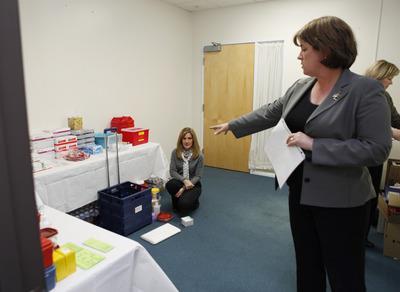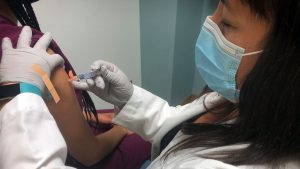For the first time, the Bay Area’s K-12 students are beginning the school year on computer screens rather than in classrooms. And if students finally return to school this year, the minutes before the morning bell won’t be spent on the playground or chatting with friends. Instead, students will be standing in line for their daily temperature checks.
A minor cough that last year would have gone unnoticed will earn a trip to an isolated room, a speedy return home and a mandated test for COVID-19.
But more than half of California school districts don’t have a nurse on staff to help them implement their plans to reopen safely. In many other districts, a single nurse is responsible for multiple schools and thousands of students.
“It’s unreasonable,” said Tracy Fernandez, regional president of the California School Nurses Organization. “Each school deserves a school nurse every day.”
Pamela Kahn, statewide president of the school nurses group, says the pandemic is exposing California’s historic lack of investment in school health.
Many school nurses have spent their summer helping to create comprehensive pandemic safety protocols. When students return, they’ll spearhead efforts to educate staff and students about safety measures, conduct daily health screenings and track any confirmed cases of COVID-19.
The extra tasks school nurses will be expected to take on are “really going to add quite a bit of burden to an already stretched, very thin workforce,” Kahn said.
Districts without a nurse on staff will be at a disadvantage, said Jill Vandroff, a nurse for the San Mateo County Office of Education. “School nurses are people who have medical training, who can read all of the reports and the guidelines, and be really important contributors,” she said. “It’s just what we’re good at.”
While some districts without credentialed school nurses employ health aides with basic first aid training, “they’re not the people who are going to be sitting on committees and helping make policy,” Vandroff added.
Unlike many states, California does not mandate that school districts hire nurses. The American Academy of Pediatrics recommends that every school have at least one nurse and that districts maintain a ratio of one nurse for every 750 students.
Only a handful of California school districts meet that standard. A 2018 report from the National Education Association said that school nurses in California were responsible for an average of 2,240 students — the 13th highest ratio in the nation.
According to Kidsdata.org, a project of the Lucile Packard Foundation for Children’s Health, San Jose Unified School District employs one school nurse for every 1,300 students. At Antioch Unified, there’s a single nurse for 17,000 students.
Lisa Tripp, district nurse for Santa Cruz City Schools, says she feels fortunate that the district has a ratio of about one nurse for every 2,500 students. “It’s not ideal, but it’s better than many,” she said.
Tripp coordinates care from the district office, visiting schools as needed to help health aides deal with injuries and manage chronic conditions. When kids return to their schools, most of the hands-on work of screening students will be handled by health aides and the front office staff. “I can’t be at four schools at once,” she said.
The statewide shortage in school nurses is partially due to the trouble districts have attracting qualified candidates. Although registered nurses need an additional year of schooling to work in schools, their salaries are often far lower than colleagues in traditional health care settings.
A larger problem, however, is the lack of funding. School districts, Tripp said, often view the role of school nurses as perfunctory and prefer to use their limited funds to hire more teachers or improve school facilities.
“It’s a constant battle to not become a victim of budget cuts,” she said. “We constantly have to show the value we bring.”
Stanford health researcher Eunice Rodriguez has spent her career putting numbers to that value. Over the past 15 years, she’s seen school nurse staffing hold steady or decrease while the number of students with chronic conditions rises.
Her research in San Jose schools has shown that when children with asthma have access to a full-time nurse, it increases attendance and reduces emergency room visits. Another study found that schools with full-time nurses were more likely to follow up with students and families after routine eye exams, making sure kids with vision problems get glasses.
“It’s really important for those more vulnerable children to have nurses,” Rodriguez said.
For some Bay Area children, the school nurse is the only medical professional in their lives.
Registered nurse Katie Rodriguez, manager of health programs for San Jose Unified, says she and her colleagues routinely help families without health insurance apply for Medi-Cal. The district, she said, also has a “long history of collaboration” with community partners such as School Health Clinics of Santa Clara County, a nonprofit that runs six low-cost clinics in San Jose and Gilroy public schools.
Those resources grow increasingly vital as a faltering economy causes many parents to lose employment and, with it, health care coverage.
For smaller districts, hiring a nurse can seem impossible.
Charles Miller, superintendent of John Swett Unified School District in Contra Costa County, said although he sees the benefits of having a school nurse, his district of fewer than 1,500 students simply can’t afford one.
If his four schools reopen while COVID-19 is still a concern, he’d like to have a health care professional on staff. But “it’s not feasible to have that through conventional means,” he said. “It has to be through some kind of supplemental funding.”
Stanford’s Rodriguez says many school districts are in the same tough spot.
For a possible solution, she points to Massachusetts, which maintains separate funds for education and student health. Implementing a similar system in California could ensure that districts don’t have to sideline school nurses as they strive to meet basic educational needs.
But hiring more nurses “might not be enough,” Rodriguez said, who stresses the importance of the connections San Jose Unified has made with local clinics, as well as the ability of the district’s nurses to coordinate with students’ families. Nurses, she said, must have “a clear mandate” to attend to the health of students both in and out of the classroom.
Vandroff agrees, envisioning a “bigger role” for school nurses that extends beyond triaging students’ immediate health care needs and focuses more broadly on public health.
Expanding the role of school nurses could allow them to proactively focus on students’ nutrition, vaccinations and other “things that keep people healthy and ready to learn,” Vandroff said. “The nurse isn’t just there for sick people.”



















